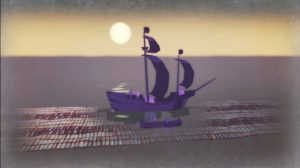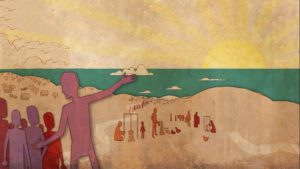Experience Design & the Art of Building A Ship
Creating a lasting, impactful experience is every company’s biggest asset. It’s also the biggest challenge: whether it’s a physical building or a website, you aren’t simply gathering together materials to create an end product. You’re creating something memorable and meaningful for people to interact with you and your brand. But how do you know it will be memorable or meaningful while you’re building it?
Great success starts and ends with making sure everyone involved is continuously focused on the larger collective goal. It’s a tall order considering how many details and items we have on our to-do lists every single day. But this kind of thinking allows a project to go from good to unforgettable. In our world, we often incorrectly define the goal as the physical product we are creating: a sports arena, a museum exhibit, a video. The goal is actually the experience we get using that product. So how do we correctly define the goal? Let’s take this powerful quote by author Antoine de Saint-Exupéry:
“IF YOU WANT TO BUILD A SHIP, DON’T DRUM UP MEN TO GATHER WOOD AND ASSIGN THEM TASKS AND WORK. INSTEAD, TEACH THEM TO LONG FOR THE ENDLESS IMMENSITY OF THE SEA.”
The “wood” are the tools, gear, and equipment. The “tasks and work” are the product we create from the tools, gear, and equipment (the ship in this case). The “sea” is the goal, that connection between product and user, between ship and sailor. The “sea” is the experience. Identifying the “sea” and making sure everyone else does too is core to the practice of Experience Design.
Let’s take Apple, who practically invented Experience Design. Their stores are so popular, not just because of the products they sell, but because of the actual experience, you get while being there. Easy to use technology is strategically spaced to give you room to explore and make decisions; “genius” staff diligently work on your problems. And lofty, light-filled store rooms make you feel relaxed. The goal—people’s lives are better with Apple—is achieved.

Museums are another great example. Our client — the National Museum of the American Indian — wanted 7 videos and interactive kiosks for an exhibit on the 300-year relationship between the US and the American Indian Nations. The kiosks and screens that display videos and interactive games aren’t the goal themselves, they work toward a single goal: the experience of visitors connecting to a part of the American Story that has been long ignored, and emerging with a new perspective on the Native Nations.
Identifying the collective goal, the “sea,” that unforgettable experience, is what Experience Design folks do on a daily basis, and it doesn’t end the moment we first identify it. Everyone involved must recognize that experience as well. A plan must then be put in place to reach that goal. And throughout the process, Experience Designers will constantly ask:
DOES THIS PARTICULAR TASK OR PRODUCT STILL WORK TOWARD ACHIEVING THE FINAL EXPERIENCE? IF THE ANSWER IS YES, WE KEEP MOVING FORWARD.
But what if the answer is “no?” What if, despite all the best strategy and planning, that unforgettable experience is not taking shape? Companies that don’t employ Experience Design will often keep going, because it’s easier than going back a few steps, it’s cheaper than devoting more time and money, but mostly because we are taught to never give up, not even when it gets bad. We also get too caught up in the execution of things to remind ourselves that the sea is still out there. Experience Design practices help keep that desired experience attainable despite small changes in course.

There’s one more part of St. Ex’s quote that is vital to that unforgettable experience: teach them to long for… the sea. Whatever the project, however big or small, we must inspire—those we work with, those we work for, and those who are supporting us even beyond the project. So, no matter what challenges arose throughout the project, the inspiration to meet those challenges will always be there. For NMAI, the media team was constantly reminded about the members of the Native Nations who fought to stay alive, who fought for their rights, and who kept their people alive despite all the odds.
In your project, how do you inspire the people around you? How do you teach them to long for the sea? If you remember that you are not creating a project or a building but rather an experience; if you remember that you are not working for a person or a company but rather for that indelible experience; if you yourself remember to long for the sea, you will have it.
Want to learn more about experience design? Chat with Jordana!
Originally published in Madison Marquette’s Places Magazine, written by Jordana Well




